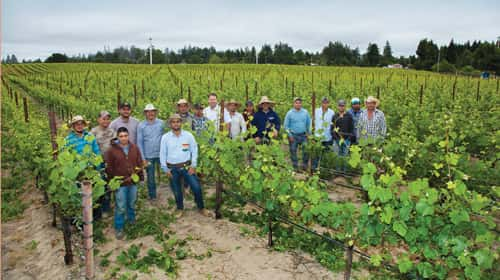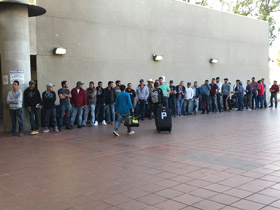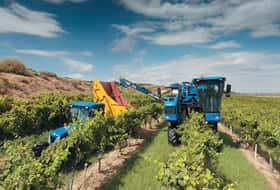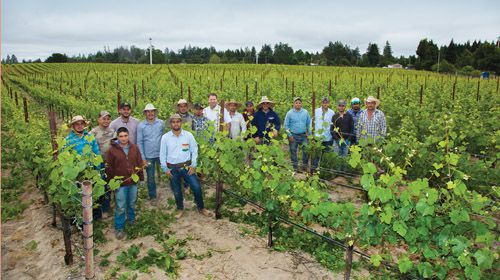
The long days of midsummer are quiet in the vineyards and orchards. The winter pruning and spring suckering are long past, and now it’s nature’s turn to do its part. The next big round of activity is the harvest, but North Bay growers are facing a challenge. It’s increasingly difficult to find enough agricultural workers. The attrition that comes with an aging labor force is one reason, and the high cost of housing in a tight market is another. In addition, immigration issues are having a significant impact, and competition from other industries has the potential to be a factor. The result is a complex problem with no easy answers.
Karissa Kruse, president of Sonoma County Winegrowers, reports that Sonoma County growers need about 4,000 seasonal employees, but had only 3,000 in 2017, and she doesn’t see any evidence that the situation will improve in 2018. Instead, conversations about the diminishing number of workers are coming up more frequently. “I really started hearing about it three or four years ago,” she says, but she believes the problem goes back much farther.
Year round
The biggest shortage is skilled seasonal workers for peak times, such as the harvest, but finding full-time year-round employees can be difficult, too—especially as older workers retire. It’s of particular concern, because they have considerable institutional knowledge, such as what canopies should look like and how many clusters of grapes are optimal for a vine, and as they age out of the workforce, they take that expertise with them. In earlier generations, children grew up expecting to follow in their parents’ footsteps, but in today’s farm families, they have the advantage of the California school system and are better educated. They often go to college, and they have no interest to work in the vineyards. “Farming is hard work,” says Kruse, who points out that they might be attracted to agriculture, but they’re interested in positions on the business side, not day-to-day farming. It’s a dilemma, she says, because without skilled workers to take over, it’s difficult to ensure consistency.
Drew Johnson, North Coast regional manager for Atlas Vineyard Management, which oversees 1,600 acres of vineyards in California and Oregon, observes that men and women who have worked in the fields for 25 years or more want better for their families. They’ve raised children who are becoming professionals, and that’s to be expected. “It’s the model that everyone wants,” he says, and it’s a measure of success for them.
Nonetheless, it has a downside for growers, and compounding the problem, few potential full-time workers are coming to settle in the North Bay and take jobs in the agriculture industry because it’s too expensive. “Housing in this area is costly and it takes a bite out of their checks,” says Kirk Lokka of Emeritus Vineyards in Sebastopol, which owns Hallberg Ranch in the Green Valley AVA and Pinot Hill Vineyard in the Russian River Valley.
Seasonal
Getting sufficient seasonal workers is a challenge as well, since so many growers are competing for similar kinds of labor at the same time. “Harvest time, all growers are scrambling to find hands to pick,” says Lokka, who had to hire labor contractors to get the grapes in on time in 2016 and 2017. It’s one strategy for getting help, but it’s a last resort, because the workers cost more, while the quality of labor often falls short. On the positive side, however, they get the work done quickly. Lokka’s preference is to retain the workers he’s hired in the past, and most of the time he’s successful. He doesn’t have much turnover, and when he does hire new employees, he pairs them with experienced employees so they can learn from them, and will hopefully come back. He’s had employees who’ve been with Emeritus for 10 years or more, and he finds that they’re his best advertisers. “If a friend or relative needs work, and the guys think they’re good, I usually hire them,” he says. And sometimes he hires more than he needs because he might not get another opportunity for months.
Johnson describes the need as cyclical and a reflection of the nature of the grape business as a whole, with big demands for labor occurring in short windows throughout the season. From December to March, growers need pruners, and in the spring, the focus is on suckering for four to six weeks. The culmination is the harvest at the end of summer or in early fall, and the problem is the gap between early summer and the harvest. If a vineyard has a slowdown or layoff, workers could leave to work on other crops elsewhere—maybe strawberries or lettuce—and they might not return. He observes that Napa and Sonoma counties are becoming monocultures dominated by grapes, so workers can’t stay and bounce from one crop to another. “They’re coming here to work on grapes,” he says. “If we’re fully staffed for spring and early summer and get them to stay or come back, we’ll be okay.”
Like Lokka, his first choice is getting the same people year after year, because they’ve had training and possess valuable skills. “I think it’s akin to a manufacturing line. You’re doing the same [task] over and over again, but it still takes trained and skilled hands to do the work,” he says. Suckering, for example, requires identifying the primary shoot and removing unwanted shoots from the bud. “It’s a thinning process, so we’re in control rather than Mother Nature,” he explains. He places workers in groups of eight to 14 people with a crew leader, who has experience working with grapes. That person is responsible for the well-being of the crew, making sure they have necessities such as water, shade and clean toilets, and is also a teacher who shows new workers what to do. Newcomers then work in rows, side by side with more experienced workers, and they learn what kind of body motions are an efficient approach to the work they’re going to do on the vines. He explains that an acre of grapes requires 30,000 touches by workers, from pruning and training to removing buds and leaves, so it’s important for them to target their movements.
Competition
Competition from other crops and industries is also a growing threat this year. Now that cannabis is legal, it also has the potential to attract the same workers we’re wanting to hire, but it’s a new business and has many unknowns. It requires different skills, and “A lot of cannabis is grown indoors,” says Kruse, so it’s not appealing to someone who likes to be outside in the fresh air surrounded by nature. “A whole new industry comes in and evolves,” she explains, and so it will take time to see if it has an impact.
A greater threat is construction, as rebuilding following the wildfires of October 2017 begins. “What makes me most nervous about this year is the competition from other industries,” says Johnson, observing that Napa and Sonoma counties have to build thousands of new homes and buildings to replace those lost in the fires. A large demand for laborers hasn’t materialized yet, because it takes time to go through the permitting process, but when it does, the promise of the stability that consistent work and a steady paycheck provide is sure to be tempting to some fieldworkers.
Immigration
Immigration laws are also impacting the labor pool. “Immigration is absolutely a factor,” says Johnson, who used to get workers who were seasonal in their work habits. They would arrive in spring and work in the vineyards and move on to work on another crop in summer—perhaps pears in Lake County. They’d return for the harvest, and then go home to Mexico for five or six months. Now, however, the labor routine has changed. “Current immigration policy has made it more challenging and stressful for people crossing the boarder,” he says. Atlas does its due diligence and hires in accordance with state and federal law, but Johnson finds that the system for ensuring someone’s documents are correct is inadequate. When hiring, he looks at a driver’s license and temporary work visa, and if they appear legitimate, he’ll put the person to work. And in his experience, foreign workers are diligent about complying with the rules set forth by U.S. Citizenship and Immigration Services. “They’re deeply motivated to keep their permits in line,” he says. According to Johnson, some workers had to leave at harvest, because their visas were about to expire. He sent them on their way and asked them to return the following year. “The pay in the vineyards is pretty good, so they’re willing to come in and do it,” he says.
Kruse believes that a program for temporary workers will always be in demand. “Many people believe that everyone who comes here wants to be a citizen,” she says, but she finds that’s not always the case. “In one day, workers earn the same as they would in a week in Mexico,” she points out. The workers are grateful to come for a short time, make good money and return to their families south of the border where the cost of living is much cheaper than in California.
A solution for some growers is the H-2A visa program, which allows foreigners to enter the country to do seasonal agricultural work. Kruse dispels the notion that workers from Mexico are taking jobs away from Americans, explaining that farmers have to post the jobs in four states first and can only look for labor outside the country if they don’t get results. The response to the available jobs is inevitably poor, so they go to the next step, which is applying for a specific number of workers while meeting transportation and housing requirements. “The housing is the big hurdle,” she says. “You can’t even think about [recruiting elsewhere] if you don’t have housing.”
 Kruse went to Tijuana in April to observe the procedure firsthand. She accompanied Steve Dutton of Dutton Ranch in Sebastopol, who has been hiring workers with H-2A visas for 11 years, and what she discovered is an incredibly complicated process. First, Dutton had to find the workers in Mexico, and then he had to make an appointment to go to Tijuana to meet them. On the designated day, he and Kruse walked across the border and went to a hotel where the men were waiting for them. “They were so excited” she says, reporting that they were dressed up, wearing shiny boots. “There was just this great energy.” Then the men had to show their paperwork and passports to government officials, and the consulate decided which ones to interview. Of 84 applicants, 12 had to have additional interviews while the other 72 received VISA approval. For the 12 who received interviews, one applicant was rejected, because he had false identification, but the other 11 got the go-ahead, with a total of 83 workers receiving approval for the H2A program. Of these, 73 men were returning having worked for Dutton Ranch the year before. They still had to be fingerprinted and are subject to strict regulations, but once they’d successfully navigated the red tape, of the three-day local process in Mexico and months of preparation, they were allowed to cross the border on foot, a few at a time.
Kruse went to Tijuana in April to observe the procedure firsthand. She accompanied Steve Dutton of Dutton Ranch in Sebastopol, who has been hiring workers with H-2A visas for 11 years, and what she discovered is an incredibly complicated process. First, Dutton had to find the workers in Mexico, and then he had to make an appointment to go to Tijuana to meet them. On the designated day, he and Kruse walked across the border and went to a hotel where the men were waiting for them. “They were so excited” she says, reporting that they were dressed up, wearing shiny boots. “There was just this great energy.” Then the men had to show their paperwork and passports to government officials, and the consulate decided which ones to interview. Of 84 applicants, 12 had to have additional interviews while the other 72 received VISA approval. For the 12 who received interviews, one applicant was rejected, because he had false identification, but the other 11 got the go-ahead, with a total of 83 workers receiving approval for the H2A program. Of these, 73 men were returning having worked for Dutton Ranch the year before. They still had to be fingerprinted and are subject to strict regulations, but once they’d successfully navigated the red tape, of the three-day local process in Mexico and months of preparation, they were allowed to cross the border on foot, a few at a time.
 “Finally, hours of security and filling out forms later, they got across,” says Kruse, and they boarded a bus that Dutton had waiting and arrived in Sonoma County early the next morning. “Those 83 men work for the Duttons, and the Duttons are responsible for them,” Kruse explains. She went to Mexico because she wanted to see how complicated the process is, but her biggest surprise was the excitement from the workers. “They know it’s hard work, but they’re excited and see this as an opportunity. They often return year after year and most of them are family and extended family members. They see it as changing their lives,” she says. “It should be easier. It’s a win-win for everyone.”
“Finally, hours of security and filling out forms later, they got across,” says Kruse, and they boarded a bus that Dutton had waiting and arrived in Sonoma County early the next morning. “Those 83 men work for the Duttons, and the Duttons are responsible for them,” Kruse explains. She went to Mexico because she wanted to see how complicated the process is, but her biggest surprise was the excitement from the workers. “They know it’s hard work, but they’re excited and see this as an opportunity. They often return year after year and most of them are family and extended family members. They see it as changing their lives,” she says. “It should be easier. It’s a win-win for everyone.”
Seeking solutions
Johnson predicts that the use of H-2A visas will grow, despite the hurdles and paperwork. “I do believe it’s going to be a large element of farming in Napa and Sonoma in the future,” he says because it solves the problem of vineyard workers who can’t afford to live here. He sees another solution in tiny houses, such as those from The Little House on the Trailer in Petaluma. “I have long had this dream to put tiny houses on our vineyard properties that would allow our workers to live on-site,” he says. If a 120-acre ranch has 10 employees, five houses to accommodate two people each, he says, it would be a nice but simple fix. Employees could step out the door to go to work, which would take cars off the road, but, more importantly, it would provide housing and a sense of ownership for them. “You’ve taken a huge step to make a happy employee, and it would be awesome from a management perspective,” he says.
Lokka reports that his solution for attracting and retaining workers is giving pay increases. Emeritus has increased pay 25 percent over the past three years and is also offering attractive benefits, which include vacation and holiday pay, health insurance and a 401(k), as well as housing for some workers. He doesn’t foresee any improvement in the labor situation this year, and as a result, many small growers will resort to using management firms and contractors to get the work done, which costs more. He thinks giving immigrant workers a longer timeframe, maybe creating a three-to five-year program and a path to citizenship if they want it, would relieve the shortage. And he would also like to see currently undocumented workers having a way to become legal residents, too. “Not amnesty like 1985, but some kind of fine or fee plus all things required for citizenship,” he says.
Kruse also believes a path to citizenship would be beneficial. She points out that some families have been here undocumented for 40 and 50 years. “It would be great to have them stay and be able to be openly engaged in the community.” In addition, she thinks the industry could find better ways to let young people know that agriculture offers different opportunities and isn’t just one thing. Santa Rosa Junior College’s agriculture department, for example, has a variety of certificate programs, including Sustainable Agriculture and Wine Business and Marketing. And even time in the field has benefits, because it provides firsthand knowledge that’s useful for other jobs. “It’s good to learn from the ground up,” she says.
New ideas and practical suggestions are all part of the continuing conversation, as growers discuss the issues and look for solutions both individually and collectively. “I hope we can find a way to keep labor in our area,” says Johnson, who stresses how important it is. “My guys make my life great. I know they’re going to do the work I ask them to. They keep our business running. They could survive without me, but I can’t survive without them,” he says.
Meanwhile, the harvest is approaching, and Kruse anticipates that growers will work longer and harder than ever. And somehow, they will get in all the fruit and produce wine that’s first class, despite the challenges. “Farmers are amazing,” she says. “They just get it done.”
Winegrower Stats
Sonoma County Winegrowers conducted a survey of wine grape growers in 2017, which determined the following:
Full-time workers: 5,186
Seasonal workers: 2,644
Pay: $16.34 per hour on average
Winegrowers offering housing: 29 percent, with a total of 950 beds
Winegrape businesses donating money to charitable causes: 74 percent
Growers making personal donation to charitable causes: 93 percent
In addition, winegrape growers and their businesses contribute more $26 million annually to support education, agricultural education, health care and the environment.
Mechanical harvesting
 Karissa Kruse, of Sonoma County Winegrowers, reports that 40 percent of the grape harvest in Sonoma County is mechanized, and it’s an alternative when growers can’t find enough harvesters. “Technology is certainly a path,” she says.
Karissa Kruse, of Sonoma County Winegrowers, reports that 40 percent of the grape harvest in Sonoma County is mechanized, and it’s an alternative when growers can’t find enough harvesters. “Technology is certainly a path,” she says.
Although Atlas Vineyard Management doesn’t use machines, Drew Johnson had experience with mechanical harvesting in a previous job and believes it has some big advantages. Among them, the amount of time saved is huge. “You can pick a lot more fruit than by hand,” he says. Johnson believes it’s better than having people work in the dark at night, when harvesting usually takes place. He adds that the equipment has gotten much better in the last 20 years, but points out that not all terrains and vineyards facilitate machine harvesting.
Kirk Lokka, of Emeritus Vineyards, reports that labor accounts for 70 percent of his costs, and he is exploring mechanization as a less expensive option. “I’m planning to hire a mechanical harvester to pick a small portion of my vineyard this year. This is for our winery to evaluate wine quality of hand harvest versus machine,” he says. In another technological advance, he expects the use of power-pruning and tying to begin next year.
H-2A Visa Program
H-2A visas allow workers from other countries to enter the United States for temporary or seasonal agricultural work. The program began in 1986, and in 1997, U.S. Customs and Immigration Services issued 16,011 visas. By 2014, the number had grown to 89,274, with the majority of workers coming from Mexico.
Employers must meet rigorous standards, which include providing free housing, which is subject to inspection and must be approved. The employer must also provide three meals a day or facilities where workers can prepare their own, and they have to provide transportation.
Federal legislators have proposed replacing the H-2A visa program with a new H-2C program as part of immigration reform, but the California Farm Bureau Federation opposes it. For more information, go to www.uscis.gov/working-united-states/temporary-workers/h-2a-temporary-agricultural-workers.




